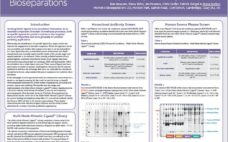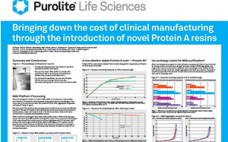Host cell proteins (HCPs) in biopharmaceuticals must be controlled in the downstream process (DSP) of antibody production, since it has critical influence on product quality. Generally, the majority of HCPs in harvested cell culture fluid are removed during the affinity step using Protein A chromatography resin, and the remaining HCPs are remove in the polishing step by a combination of ion-exchange chromatography, hydrophobic interaction chromatography, etc. Thus, identification of remaining HCPs after Protein A affinity chromatography process can work as…
Year of Publication
Multi-Mode Mimetic Ligand™ Library – A Rapid Screening Toolbox for Target Protein Purification
Small synthetic ligands have established themselves as an essential component of modern downstream processes, both as specific ligands for product capture or the targeted removal of impurities and more generally for product polishing applications. Historically, the identification of a specific ligand for a target protein has required the engagement of specialist companies. Whilst this approach can be very successful, such studies often require some time to set-up and perform (i.e. from ligand discovery, to adsorbent/process development and finally manufacture) and…
Targeting Desired N-Linked Glycosylation Profiles Through The Use Of Glycosylation Enhancing Feeds And High Throughput And High Resolution N-Glycan Analysis By Multi Capillary Electrophoresis
Glycosylation is a key product quality attribute for many biotherapeutic proteins expressed in CHO cells. N-linked glycans may display macro- and micro-heterogeneity; the degree of this variation can depend on several factors, including cell line, media/feeds, and process. As a consequence, it has often been challenging to achieve and maintain preferred glycosylation profiles from cell culture development through bioreactor scale-up. In order to address these challenges, we have developed a new feed technology in conjunction with a unique fed-batch process…
High Density Culture Strategies For Improved Scalability With Single-Use Systems
Improvements in single-use systems have allowed implementing high-density cultures in standard work flows. The current study shows integration of the Thermo Scientific™ HyPerforma™ Single-Use Bioreactor (S.U.B.) and the XCell™ ATF6 Single-Use (SU) System to achieve high-density cultures. Current results are compared against similar cultures using a stainless steel ATF6 system. The S.U.B. was able to support high-density cultures (>40E06 cells/mL) without modification to standard single-use components and maintained proper operating parameters. Scale-up criteria for both S.U.B. and ATF are provided…
Rapid and Simple Sample Preparation for High Throughput, High Resolution and Sensitive Glycan Analysis by Capillary Electrophoresis
Here, we report the simple and rapid GlycanAssure™ workflow that combines high throughput and high resolution glycan analysis of 96 samples in 7-9 hours using Applied Biosystems™ 3500xL 24-capillary electrophoresis system. The process eliminates vacuum drying and highly toxic cyanoborohydride in the labeling reaction. Use of Dynabeads™ magnetic beads for glycan purification post deglycosylation and removal of free dyes after labeling streamlines the process for automation. Capillary electrophoresis can detect less than 0.2 fmol/ÎĽL of labeled glycans. Two proprietary fluorescent…
Innovative Hydrophobic Interaction Chromatography (HIC) Resins for Next Generation Molecule Challenges
Advances in biotherapeutics are generating a wider range of biomolecules that are presenting unique and often difficult separation and purification challenges. Based on the complex needs of the industry a series of HIC prototypes were developed over a range of hydrophobicity. Utilizing extensive user input, design goals focused on development of resins with market leading resolution and capacity, as well as optimized surface and flow characteristics for increased throughput and high product recovery. All of which are typical pain points…
Decreasing Cost of Clinical Trials Through the Use of Two Novel Protein A Resins
Tackling the High Cost of Protein A in Early Clinical Phases The cost of Protein A resins is very high, commonly 5-10 times higher compared to standard chromatography resins. One way to address this issue is to use a less expensive Protein A resin during early clinical trials, where the risk of failure is higher and fewer cycles are run, and subsequently switch to a resin designed for manufacturing if the product makes it to PIII and beyond. The higher…
A Fresh Approach to Process and Cost Efficiencies in Early Clinical and Biosimilars Production
This poster will introduce Praesto™ AC protein A resin and ProcessReady pre-packed columns from Purolite. Platform processes for MAbs manufacturing have long been used to save time and costs. The use of highly productive, cost- effective resins in such platforms can magnify these savings, and the addition of ready-to use formats can further enhance process efficiencies. Our approach is to maximize these efficiencies and cost savings in early clinical-phase production and in the manufacture of biosimilars by using stage-appropriate materials…
CryoPod™ Carrier: Standardized Portable Cryogenic Handling of Cellular Therapies
Temperature control during sourcing, manufacturing, and delivery of cell therapies is crucial, as fluctuations can affect viability and function of the cells, and potentially, the overall efficacy and safety of the therapeutic product. In many cell therapy workflows, source cells arrive cryopreserved at LN2 temperatures (-150 to -196 °C) and post-manufacturing, cells are again cryopreserved and stored in vapor- or liquid phase LN2 prior to their use in the clinic. In either case, containers filled with dry ice (-50 to…
Efficient Optimization of CHO Cell Culture Medium and Feed for Increased Antibody Production
Traditional medium optimization strategies are labor intensive, costly, and time consuming. In this project, high-throughput screening technology was adopted along with statistical design to reduce costs and decrease time for optimizing culture conditions for maximized antibody production from a custom Chinese hamster ovary (CHO) cell clone. The presented work includes two phases: phase 1 for basal medium optimization and phase 2 for feed optimization. Phase 1 and phase 2 each have two rounds. A DoE screening methodology was used to…










